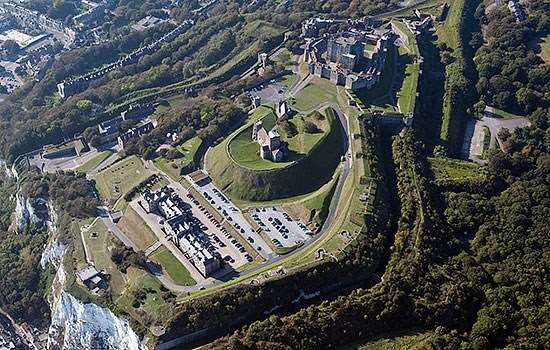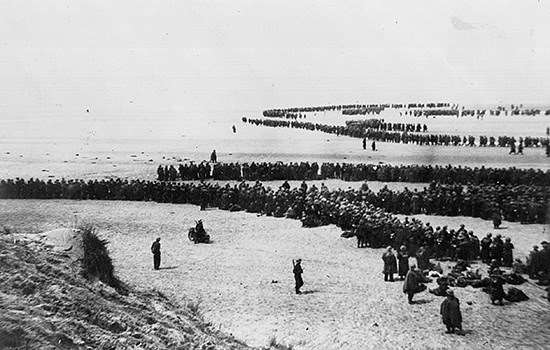New Barracks and Fortifications
Before 1744, the old castle accommodated only one or two companies of infantry (up to 160 men) and sometimes a troop of cavalry (up to 48 men). From that date until 1752, the dilapidated buildings of the inner bailey and the great tower were repaired or rebuilt for use as barracks for a much larger force.
The end of the War of Austrian Succession brought only temporary peace. During the Seven Years War (1756–63), Great Britain fought with France on a global scale and further modernised Dover in 1755–7. The military engineer in charge, Captain John Peter Desmaretz, was conscious that Dover’s northern defences were vulnerable to artillery fire from higher ground, and to close attack across the abandoned medieval barbican (a fortified enclosure outside the gate of the castle).
He addressed this problem in 1756–7 when he lowered the outer castle wall and towers on the north-east side and placed a massive earth rampart behind to help absorb the impact of incoming artillery fire and to form a platform for cannon. Further back in the castle he built two new batteries of ten powerful 24-pounder cannon, to fire over the new north-eastern rampart and counter the threat of enemy guns on the higher ground there.
Captain Desmaretz also reformed the area of the old barbican into a new outer fortification called the ‘Advanced Work’ for infantry. It comprised a rampart with a firing step, a steep outer slope studded with sharpened stakes, and a deep external ditch. Inside the Advanced Work, the old tunnel between the castle and the barbican was repaired and made secure with a new guard room.
Additional (temporary) barracks were erected in the middle bailey, bringing the total of soldiers in garrison to over 1100, in fourteen companies of infantry. Such a force was large enough to defend the castle and to go out to help in resisting an enemy force that had landed elsewhere in the area.
Joining the Army
Some men joined the army out of patriotism, but most enlisted to escape poverty in civilian life. Some were tricked into uniform.
In general, society regarded rank and file soldiers as immoral, violent and drunken, yet war demanded thousands of recruits to a service with low pay and brutal discipline. So why did men enlist? Adventure and pride in fighting the nation’s enemies motivated some, but many joined to escape a life of back-breaking labour, destitution, debt or trouble with the law.
Despite cash incentives to enlist, too few came forward, so recruitment extended to men from other countries. Trickery was also used: some men signed up when they were drunk and others were persuaded by false promises. The result was an army whose ordinary soldiers enlisted largely because of financial necessity, or because they had been cleverly entrapped. Despite this, many of them proved to be good soldiers.
The American Revolutionary War
The Seven Years War ended in 1763 but only 12 years later, fighting broke out in the American Revolutionary War (1775–83) and eventually the military threat expanded into Great Britain’s home waters. In 1779, a combined French and Spanish fleet carrying over 40,000 troops from Le Havre and St Malo set sail for the south coast of England. A British fleet forced it to retreat but the threat led to more defensive measures in Dover. New gun batteries were built on Dover’s foreshore, and new fortifications were begun on Western Heights on the opposite side of Dover to the castle, to defend against potential attacks by an enemy that had landed in the Folkestone area.
Resources allocated to the castle were probably spent on new gun batteries to provide even more firepower northwards, as well as a temporary magazine for gunpowder erected in the ruinous church of St Mary-in-Castro, at the highest point of the castle.
The French Revolutionary War
The onset of war in 1793, with much of Europe pitched against Republican France, brought a renewed and serious threat to Dover and its coastline. An enormous, expensive programme of refortification began right across the castle, town and the Western Heights, lasting until the war’s end in 1815. This was directed by another engineer officer, Lieutenant Colonel William Twiss. At the castle, the aim was to transform the ageing castle into a modern fortress. This involved re-shaping and adding substantially to the defences around the entire perimeter.
The ‘Advanced Work’ was renamed ‘the Spur’ and re-shaped as a ‘ravelin’, a precisely triangular earthwork with a rampart shaped as a firing position for infantry. Within the ravelin, a ‘redan’ (a V-shaped fortification) was formed as an inner strongpoint. It was raised higher to defend the perimeter of the ravelin and to fire over it onto the land beyond, and protected by a deep, vertical-side ditch.
The redan incorporated a concealed guard room that protected the only entrance into the 13th-century tunnel that led underground into the castle. The tunnel was retained but modernised as a means of getting troops out onto the Spur quickly to defend it. This included the creation of caponiers – covered galleries in the castle ditch, with small openings in their sides for musket and cannon fire to prevent enemy soldiers from crossing.
Along the castle’s east and west outer walls right down to the White Cliffs there was little provision for close defence. That meant that any enemy soldiers that managed to get to the foot of the walls could not be fired upon. To solve this, defences were built out from the wall and across the ditch to prevent the enemy climbing or undermining them. Huge earthwork bastions projected on the east and west. Some of the new bastions were reached by long underground tunnels from inside the castle.
The lowering of the east wall of the castle was accompanied by a huge earth rampart behind it that incorporated a huge battery of cannon. Along the west wall, many of the old medieval towers were lowered and provided with cannon, and the walls between had their old crenelations removed and replaced with firing steps for infantry.
Life in the New Barracks
Inside the castle, there was a host of new buildings including bombproof barracks (‘casemates’) built in 1796–8. The Spur Casemates were built in the northern part of the interior and the Cliff Casemates were excavated 25m underground at the southern end, deep in the chalk of the White Cliffs.
Elsewhere, the great tower ceased to be a barracks and was converted into a huge ordnance store for gunpowder, shot and shell and other warlike supplies.
The garrison of the castle remained large and the castle was a busy place with the constant movement of soldiers, materials and supplies. Infantry units came and went frequently, sometimes after only a few weeks but rarely more than a few months. This was a deliberate policy to prevent soldiers developing local attachments and relationships.
Conditions in barracks were basic, crowded and often smelly and insanitary. Pay was low and although food was plain and repetitive, it was at least provided regularly, more regularly than many had in civilian life. Soldiers at Dover had to be ready to fight, so daily life mainly comprised of weapons drills and manoeuvres, with other duties including mounting guard and patrols, cleaning equipment, parades, inspections and policing civilian disturbances. Dover’s vast building site also provided opportunities for soldiers to supplement their meagre pay with extra work.
Families at Dover
The army discouraged soldiers from marrying but they could seek permission from their commanding officer. Soldiers’ wives performed key support tasks in their regiments.
Women were not allowed in barracks unless they were married and officially on the list of people in the regiment. If officially recognised they and their children could enter. Around 7 per cent of soldiers were officially allowed to marry, but sometimes others were permitted to do so unofficially by their commanding officers. Women in barracks lived with their husbands among the rest of the soldiers. Privacy was impossible, but, in some barracks where space allowed, a whole room might be given to the women and children.
Wives – both official and unofficial – fulfilled key tasks, supporting their husbands and children and earning money by washing, mending, cleaning and cooking. These were not their only jobs: some assisted surgeons with wounded men, and a few fetched food, water and ammunition in action. Satiricists may have mocked the domesticity of family life in the barracks, but in reality many wives were respected for their strength and commitment by the whole regiment.
By Paul Pattison
Explore more
-

History of Dover Castle
Learn about the long history of the castle, from its likely origins as an Iron Age hillfort, through its development as a great fortress, to its secret role in the Cold War.
-

The Sieges of Dover
Read about the two sieges of Dover in 1216 and 1217 during King John’s reign, and the circumstances that gave rise to this attack.
-

Fortress Dover and the First World War
During the First World War an obsolete gun battery within Dover castle was transformed into a command and control centre that played a vital part in safeguarding Dover as a garrison and naval base. Explore this building in our virtual tour.
-

Operation Dynamo: Things You Need to Know
Find out the key facts about Operation Dynamo, the near-miraculous evacuation from Dunkirk in 1940, which was controlled from Dover Castle.
